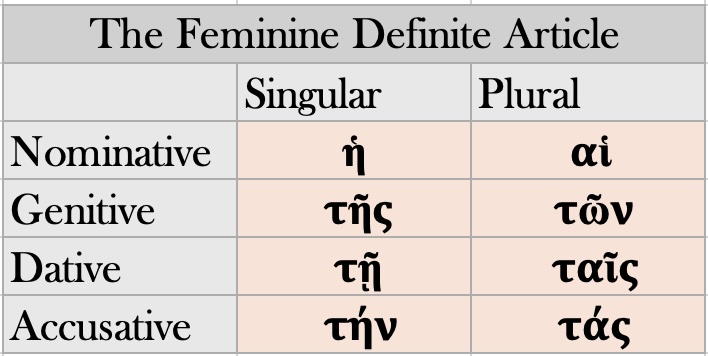9.1 In our last lesson, we learned endings for nouns that were masculine. Now we add nouns that are FEMININE. For the THIRD DECLENSION, feminine nouns use the same case endings as masculine nouns:
The Trouble with Sigma:
9.2 As noted in our discussion of masculine nouns, two of the case endings involve adding a sigma to the stem: nominative singular = –ς, dative plural = –σι. Let us look at the sound changes that occur when these sigmas are added to the stems for two feminine nouns:
- ἐλπιδ- hope
- νυκτ- night
Note that the first stem, ἐλπιδ, ends in a dental (-τ/-δ/-θ). As we know, when a sigma follows a dental, the dental disappears and the sigma remains: e.g., δ + σ = σ. The second stem, νυκτ, ends in –κτ, a stem ending that the Greeks treated as essentially the same as a palatal (-κ/-γ/-χ). Recall that when a sigma follows a palatal, the result is the double consonant ξ: e.g., κ + σ = ξ (S 241).
9.3 With these sound changes in mind, note how ἐλπιδ- and νυκτ- decline:
The Feminine Definite Article:
9.5 Note that the vocabulary entry for our two nouns begins with ἡ. This is the DEFINITE ARTICLE for all FEMININE NOUNS (S 332, G 61). Recall that the definite article in Greek must match its noun in gender, number, and case. As with the masculine forms of the definite article, the feminine needs eight forms to cover the two numbers (singular and plural) and four cases (nominative, genitive, dative, accusative):
9.6 Most nouns have only one grammatical gender. A handful of nouns referring to people or gods, however, can be either MASCULINE or FEMININE, depending on the gender of the person/divinity. In such instances, the vocabulary entry includes both the masculine and feminine article.
- παῖς, παιδός, ὁ, ἡ (male or female) child
- δαίμων, δαίμονος, ὁ, ἡ (male or female) divinity





